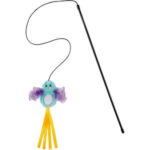The Chartreux Cat, a breed as captivating as its enigmatic history, is renowned for its striking blue-gray coat and calm, amiable temperament. Originating from France, this feline is often described as a “gentle giant” due to its sturdy build combined with a remarkably docile nature. If you’re seeking a quiet yet playful companion with an air of sophistication, the Chartreux might just be the perfect cat breed for you.
Delving into the History of the Chartreux
The precise origins of the Chartreux remain shrouded in a bit of mystery, yet historical accounts firmly place this breed’s existence as far back as the 15th or 16th century. The unique, dense, woolly coat of the Chartreux hints at a possible lineage tracing back to Syrian cats, fueling the popular theory that Crusaders returning to France from Syria were responsible for bringing the early ancestors of this breed to Europe.
Once established in France, the Chartreux quickly proved its worth as a highly effective natural pest control agent. Numerous historical narratives suggest that Carthusian monasteries in France were home to colonies of these cats, valued for their prowess in keeping rat and mice populations under control. While official Carthusian records lack explicit confirmation of this, the story persists, often cited as a charming explanation for the breed’s characteristically quiet and almost monastic demeanor. These cats are known for their reserved vocalizations, adding to their mystique.
Moving into more recent history, the narrative of the Chartreux becomes clearer. In the 1920s, sisters Christine and Suzanne Leger stumbled upon a colony of distinctive blue-gray cats inhabiting Belle-Île, an island off the coast of Brittany, France. Impressed by their remarkable appearance and the unusual woolly texture of their coats, the Leger sisters decided to domesticate and systematically breed these felines. By 1931, their efforts led to the Chartreux making a debut at a Paris cat show, marking a significant moment in the recognition of the modern Chartreux breed.
Like many pedigree breeds, the Chartreux faced a serious threat to its survival during World War II. To ensure the continuation of this ancient breed, breeders carefully implemented selective crossbreeding programs, incorporating breeds such as Russian Blues, British Shorthairs, and Persians into the Chartreux lineage. This strategic intervention was crucial in preserving the Chartreux from potential extinction.
Initially prized for their hunting skills and utility, the Chartreux gradually gained popularity for its captivating beauty, characterized by its plush woolly coat, coupled with its notable intelligence, and a consistently calm and friendly disposition. Cat fanciers and breeders worldwide recognized the appeal of this breed. In 1970, John and Helen Gamon introduced the first Chartreux cats to the United States, laying the groundwork for the breed’s formal acceptance into the prestigious Cat Fanciers’ Association (CFA) in 1987.
Today, the Chartreux holds a special place as a near-national treasure in France, deeply cherished by the French populace. However, purebred Chartreux cats remain relatively scarce outside of Europe. Interestingly, a number of breeding programs that were established in the United States have, over time, returned their breeding stock to France, contributing to the limited availability of purebred Chartreux kittens in North America.
:max_bytes(150000):strip_icc()/Chartreuxcatonpillow-2909d97b5d1f4c38b8dbf39f6e85296a.jpg)
Chartreux Cat Care: A Low-Maintenance Companion
The Chartreux cat is generally considered an easy-to-care-for breed, known for its independent nature and relatively low-maintenance needs. While they are self-sufficient, they deeply appreciate and enjoy interactive playtime and affection from their human families. They are known to get along famously with children and other household pets, making them excellent family companions. Despite their friendly nature, they are not overly demanding of constant attention, fitting well into various lifestyles.
Renowned for their high intelligence, Chartreux cats thrive on mental stimulation. Engaging them with interactive toys, puzzle feeders, and even teaching them tricks can be highly rewarding for both cat and owner. Their curious and clever nature sometimes leads them to explore their environment thoroughly – some Chartreux have been known to open cupboards and cabinets! If your Chartreux exhibits this inquisitive behavior, childproof locks on cabinets might be a wise addition to your home, especially for storing cat treats and food.
The Chartreux’s distinctive soft, woolly coat is surprisingly easy to maintain. Unlike some breeds that require frequent brushing, many grooming experts recommend using a comb rather than a brush on a Chartreux. This is because their unique coat texture benefits more from the action of a comb to prevent mats and tangles. While Chartreux cats are meticulous self-groomers, regular combing sessions provide an excellent opportunity to strengthen the bond between you and your feline friend, while also keeping their coat in top condition.
Chartreux cats do experience seasonal shedding, typically a couple of times a year, when they shed their undercoat. During these periods of heavier shedding, more frequent combing – perhaps daily – can help manage loose fur and minimize shedding around your home. Bathing a Chartreux is rarely necessary, as they maintain excellent hygiene themselves.
:max_bytes(150000):strip_icc()/Chartreuxcatwithorangeeyes-1336271b7e0c4f0a93f5d5f5ce7787bd.jpg)
Common Health Considerations for Chartreux Cats
The Chartreux is generally considered a robust and healthy breed with relatively few inherent health problems. However, like all breeds, they are predisposed to certain health conditions that potential owners should be aware of:
- Polycystic Kidney Disease (PKD): PKD is a hereditary condition where fluid-filled cysts develop in the kidneys. These cysts can gradually enlarge and impair kidney function over time. Early detection and management are crucial. Reputable breeders screen their Chartreux cats for PKD to minimize the risk of passing this condition to kittens.
- Struvite Crystals: Chartreux cats can be prone to developing struvite crystals in their urinary tract. These small mineral formations can occur when the urine is too alkaline or if the cat is not adequately hydrated. Struvite crystals can cause bladder irritation, urinary tract infections, and, in severe cases, urinary blockages, which are life-threatening, especially in male cats. Proper diet and ensuring ample fresh water intake are key preventative measures.
- Luxating Patella: This condition involves the kneecap (patella) slipping out of its normal groove. Luxating patella can range in severity, from mild cases causing intermittent lameness to more severe cases requiring surgical correction.
Regular veterinary check-ups are vital for all Chartreux cats to monitor their overall health and detect any potential health issues early. Discussing preventative healthcare strategies, including diet and screening for breed-specific conditions, with your veterinarian is highly recommended.
:max_bytes(150000):strip_icc()/Chartreuxkittenonpillow-de03e4b83ad24f1d9ac82c86687f06e8.jpg)
Appearance: The Unmistakable Chartreux Look
The Chartreux boasts a distinctive and captivating appearance. Their defining feature is their solid blue-gray coat, which has a unique woolly texture, often described as feeling like sheep’s wool. This medium-length coat is not only beautiful but also provides insulation. Adding to their striking look are their brilliant copper to orange-colored eyes, creating a vivid contrast against their gray fur.
Chartreux cats are characterized by a muscular and sturdy build, giving them a somewhat powerful appearance. They may sometimes appear to have legs that are slightly short in proportion to their body size, and their body length is typically noticeably greater than their height. While their proportions might seem unusual at first glance, this athletic build contributes to their agility and prowess as hunters and playful companions. Their “smiling” facial expression, due to the shape of their muzzle, further enhances their endearing charm.
Diet and Nutrition for a Healthy Chartreux
Providing a balanced and nutritious diet is essential for maintaining the health and well-being of your Chartreux cat. It’s important to monitor their food intake and avoid overfeeding, as Chartreux can be prone to weight gain if their diet is not carefully managed.
Given their predisposition to struvite crystals, dietary considerations are particularly important for this breed. Consult with your veterinarian to select a high-quality cat food that is formulated to promote urinary tract health and is not excessively alkaline. Many plant-based cat foods can contribute to higher urine alkalinity, which may increase the risk of struvite crystal formation.
Ensuring your Chartreux has constant access to fresh, clean drinking water is paramount. Adequate hydration is crucial for diluting urine concentration and preventing the formation of struvite crystals. If your cat tends to drink less water, consider incorporating wet food into their diet. Wet food has a higher moisture content and can significantly contribute to their daily fluid intake.
Finding Your Chartreux: Adoption and Breeders
Bringing a Chartreux cat into your life can be an incredibly rewarding experience. However, finding a Chartreux, particularly in the United States, may require some patience and persistence. Chartreux breeders in North America are not as common as breeders for more popular breeds.
To begin your search for a Chartreux, reputable resources include the Cat Fanciers’ Association (CFA) Breeder Directory and The International Cat Association (TICA) Breeder Directory. These directories can help you locate registered breeders who adhere to ethical breeding practices.
While less common, it’s also worth checking local animal shelters and rescue organizations. Occasionally, purebred Chartreux or Chartreux mixes may become available for adoption. Adopting a cat in need is a wonderful option if you are open to it.
For those specifically seeking a purebred Chartreux kitten and are finding limited options in the United States, exploring breeders in Europe, particularly in France, might be necessary. If considering this route, ensure you research breeders thoroughly for their ethical practices and the health of their cats.
Chartreux Cat Overview: A Calm and Charming Companion
The Chartreux cat is celebrated for its remarkably calm and gentle demeanor, making them wonderful companions for a variety of households, including single individuals and families alike. They thrive in environments where they are treated with kindness and respect, making them well-suited to homes with children and other pets, provided that gentle and respectful interaction is taught and practiced. Interestingly, Chartreux cats are also known for their adaptability and often adjust well to travel, making them convenient companions for owners who are frequently on the move.
Pros:
- Friendly and docile temperament
- Not overly demanding of attention
- Good with children and other pets
- Adaptable and travels well
Cons:
- Can be difficult to find a breeder, especially outside of Europe
- Predisposition to kidney problems and urinary issues
- May become bored if not provided with sufficient mental stimulation
In conclusion, the Chartreux cat is a truly special breed, offering a unique combination of striking looks, gentle personality, and relatively easy care needs. For those seeking a quiet, intelligent, and affectionate feline companion, the Chartreux is an excellent choice, provided you are prepared for the potential challenges of finding a reputable breeder and are committed to providing for their specific dietary and health needs.
13 Smartest Cat Breeds Who Are Very Witty Kitties
Explore More Cat Breeds
If the Chartreux’s qualities pique your interest, you might also find similar appeal in breeds like the Russian Blue or British Shorthair, known for their calm temperaments and plush coats.
Alternatively, explore our comprehensive collection of cat breed profiles to discover the perfect feline match for your lifestyle.


